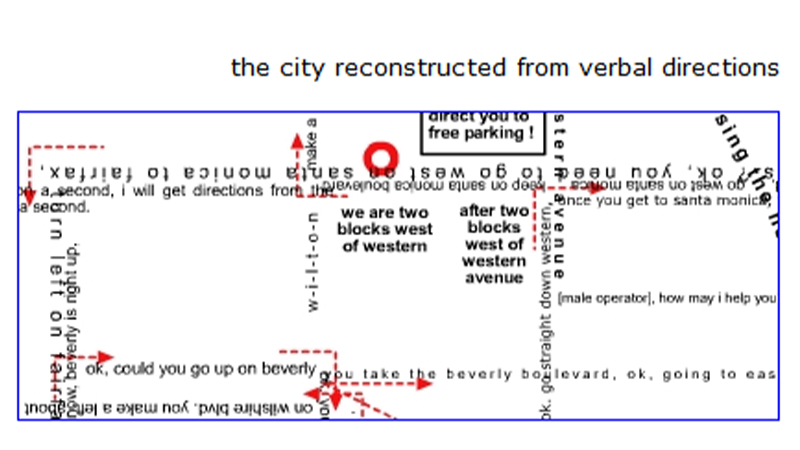The interventions of Wegzeit: The Geometry of Relative Distance were prompted by the observation that "[w]hen you ask someone in Los Angeles how far it is from the beach to downtown, he or she will answer with the number of minutes it generally takes to traverse the distance rather than noting the number of miles. This system of defining and representing distance has recently been codified for use on the California Department of Transportation's large LED 'Freeway Condition' signs, which offer up-to-the-minute projections of estimated drive times: '8 minutes to downtown;' '22 minutes to 605 freeway,' and so on. Intrigued by the shift from the absolute units of distance traditionally used to describe space to the relative space of approximate drive times, Dietmar Offenhuber undertook an investigation of other examples in which data about the city is visualized in relative terms. The result of his work is [this project], which uses six 3-D mapping paradigms – or cartograms – to visualize the city according to a range of conditions and interests.
In one cartogram, Offenhuber shows what he calls 'zones of velocity,' which illustrates differing sectors according to the speeds traveled therein. Another model shows how the experience of temporal distance is generally asymmetrical depending on a range of factors; he calls this 'the rush hour slope.' The maps offered by Offenhuber help demonstrate the potential malleability of cartography, as well as the significance of the manner in which data is made visual. While we all know the limits, ideological and otherwise, of maps, Offenhuber's attention to the relative over the absolute offers a productive refiguring of cartographic principles which can only be enacted in a dynamic, digital form. Wegzeit is interested in exploring ways of representing space in an abstract sense, merging the subjective parameters of individual navigation with the broader implications of an integrated network of data." – Vectors Journal Editorial Staff
Author's Statement
"Wegzeit is my thesis project in architecture, completed in 2002. It deals with the different notions of space we use in our daily routines, and its goal is to find visual models for these subjective spaces.
During my studies, I have always been more interested in aspects of the existing environment than in planning singular new buildings. Wegzeit is also a criticism of the traditional representation of space used used in architectural practice, the exocentric view from far above and outside, that has little in common with the spaces of our everyday experience.
(You will need to install Virtools to view the entire project.)" -- Dietmar Offenhuber, Vectors, Volume 1, Issue 2, Spring 2006
Designer's Statement
"From the designer's point of view, Wegzeit is a collection of six different mapping sketches, in which I investigate the notion of 'relative space.' In traditional maps, information is placed into an existing spatial grid with a certain scale. In my models, information is expressed only by their spatial relations; there is no grid, no scale. The distance between two elements (rather than their physical distance) shows their relationship." -- Vectors Journal Editorial Staff, Vectors, Volume 1, Issue 2, Spring 2006
Project Credits
"2000-2002 Dietmar Offenhuber
thanks:
Laura Beloff
Dr. Bob Martens
Norman Klein
— Dietmar Offenhuber, May 19th, 2008
Dietmar Offenhuber, Author
Dietmar Offenhuber, born 1973, graduated with a degree in Architecture and has been working since 1994 in animation, interactive environments and digital architecture. Between 2002 and 2004 Dietmar worked as key researcher in the Interactive Space departement at the Ars Electronica Futurelab. Since Fall 2004 he is teaching animation at the Polytechnical University of Hagenberg in Austria." -- from Vectors, Volume 1, Issue 2, Spring 2006
1 COPY IN THE NEXT
Published in Spring, 2006 by Vectors in Volume 1, Issue 2.
This copy was given to the Electronic Literature Lab by Erik Loyer in November of 2021.
PUBLICATION TYPE
Online Journal
COPY MEDIA FORMAT
Web


